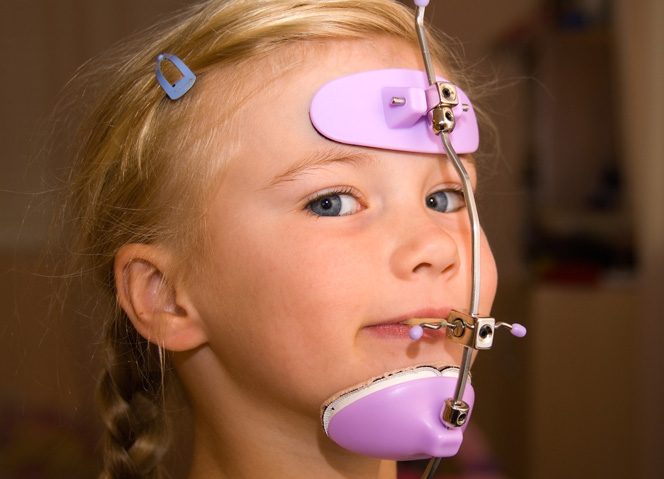Dentofacial Orthopedics in Kochi

Dentofacial orthopedics is a dental specialty that focuses on the growth and alignment of jaw bones to improve the shape of the face and jaw. This treatment is recommended in childhood because the jaw bones are in the developing stage. Unlike traditional braces, which primarily align teeth, dentofacial orthopedics addresses jaw irregularities that may require early intervention also taking treatment at the right time allows you to avoid the need for more complex treatments in the future.
By using advanced appliances and techniques, we correct jaw imbalances and ensure proper facial development. This enhances overall oral health and helps with smile correction. Appliances such as palatal expanders, headgear and functional appliances like Herbst and Twin Block are used in this treatment. For adults, orthognathic (jaw) surgery may be required along with these for producing results.
Dentofacial Treatment in Children
Starting dentofacial orthopedic treatment at an early age can have several benefits. The best age group to get treatment is 7-12, when the jaw is still developing. At this stage, treatment is less complicated and more efficient. As the upper and lower jaws are developing, early consultation can prevent skeletal misalignments from getting worse.
Dentofacial orthopedics treatment for children below 12 years is generally faster, less invasive, and more effective. As children grow older, bone growth slows down, and the jaw bone becomes more rigid. This makes corrections more difficult. After that orthognathic surgery may be required to correct the jaw structure.
Is Dentofacial Orthopedics Right for Smile Correction?
Jaw growth significantly affects the face structure, including alignment of teeth, position of the nose, cheekbones, and sinuses. The upper jaw (maxilla) supports the midface, including the nasal cavity and sinuses, while the lower jaw (mandible) defines the jawline and chin. Any imbalance in jaw growth can lead to asymmetry, bite issues, and even breathing difficulties. These types of misaligned jaws can affect facial harmony and result in a sunken or projecting midface. This affects the position of the nose and cheekbones. It can also lead to a receding or overly prominent chin and bite issues like overbite, underbite, or crossbite.
Dental care treatments for Dento facial orthopedics can promote the growth of the upper and lower jaws to achieve facial symmetry. Specialized appliances like palatal expanders can widen the upper jaw creating space for proper nasal airflow and improving sinus function. Functional appliances like Herbst or Twin Block help reposition the lower jaw forward, correcting a receding chin. Braces and Clear aligners refine bite alignment for a well-balanced smile. Through these dental care treatments, you can ensure proper jaw positioning, bite alignment and smile correction. This helps you enhance facial symmetry, creating a well-proportioned face.
Properly aligned jaws expand the nasal passages, improving airflow and reducing breathing obstructions. It can also prevent sleep-disordered breathing issues, such as snoring. Preventing long-term bite and jaw joint issues can reduce the risk of TMJ (temporomandibular joint) disorders, which can cause pain, headaches, and jaw clicking. It also contributes to improving chewing efficiency. A properly aligned jaw leads to a balanced and attractive smile. This reflects your confidence and promotes better oral hygiene.
FAQ
The best age to start dentofacial orthopedic treatment is typically between 7 and 10 years old, when a child’s jaw is still growing and more responsive to correction. Early intervention during this stage can help guide proper jaw development and potentially prevent more complex issues later.
Orthodontic treatment, such as braces or aligners, to align the teeth follows after dentofacial orthopedic treatment. Regular follow-ups are important to monitor growth and ensure the jaw and teeth continue to develop correctly. Retainers may also be recommended to maintain the results.
In many cases, yes. Dentofacial orthopedics is often done first to guide jaw growth, followed by braces to straighten the teeth. This combined approach is especially effective in children and adolescents, helping to achieve both functional bite correction and an aligned smile. Your orthodontist will determine the best sequence based on your individual needs.
Dentofacial orthopedics can help improve a gummy smile if the cause is related to jaw growth or positioning, especially in growing children. The treatment can reduce excessive gum display by guiding the development of the upper jaw. However, in adults or more severe cases, additional procedures like orthodontics or surgery may be needed for getting results.
Yes, dentofacial orthopedics can help correct facial asymmetry, particularly in children and adolescents whose jaws are still developing. It can improve balance and symmetry in the face by guiding the growth of the jaws. In adults, however, more severe asymmetries may require both orthodontics and surgical intervention.
Yes, dentofacial orthopedics can often prevent the need for jaw surgery, especially when started early during childhood or adolescence while the jaw is still growing. By guiding proper jaw development, it can correct skeletal imbalances before they become severe. In some cases, early orthopedic treatment reduces or eliminates the need for surgical intervention later in life.

